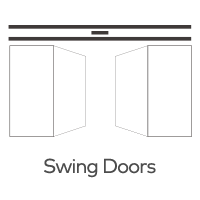Can automatic revolving door sensors differentiate between people and objects to prevent accidents?
Automatic revolving doors have become a common sight in many modern buildings, providing not only a touch of elegance but also practical benefits in terms of traffic control and energy efficiency. The safety of these entrances is paramount, and to ensure this, they are equipped with a variety of sensors. One critical aspect of safety is the ability of these sensors to differentiate between people and objects, preventing accidents and ensuring smooth operation. In this article, we will explore the technology behind automatic revolving door sensors and their capacity to distinguish between individuals and inanimate objects.

The Role of Sensors in Automatic Revolving Doors
Sensors in automatic revolving doors play a crucial role in detecting and monitoring the presence of individuals and objects, enabling the doors to operate safely and efficiently. These sensors work in harmony to ensure the following key functions:
1. Detection of Approach: Motion sensors are commonly employed to detect when someone approaches the revolving door. These sensors use various technologies, such as infrared (IR), ultrasonic, and microwave, to sense motion within a certain range. When someone approaches the door, the sensors trigger its movement.
2. Safety Measures: To prevent accidents, automatic revolving doors are equipped with safety beams and presence sensors. Safety beams emit a beam of light across the door's entrance. If this beam is interrupted by an object or person, it signals the door to stop or reverse its rotation. Presence sensors, on the other hand, detect the presence of individuals within the door's chambers, ensuring the door does not close on anyone.
3. Distinguishing Between People and Objects: The ability to differentiate between people and objects is crucial for the safe operation of revolving doors. This is achieved through the use of advanced sensor technology and programming.
Advanced Sensor Technology
Automatic revolving door sensors have evolved significantly over the years. They now employ more advanced technology to accurately distinguish between people and objects, reducing the risk of accidents. Some of the technological advancements that contribute to this capability include:
1. LiDAR Technology: LiDAR (Light Detection and Ranging) sensors use laser beams to create a 3D map of the environment. This technology can differentiate between the unique characteristics of humans and objects, helping the door recognize when a person is approaching.
2. Image Recognition: Some revolving door systems are equipped with cameras and image recognition software. These cameras can analyze the images they capture and identify the shape and characteristics of individuals, ensuring the door responds appropriately.
3. Proximity Sensors: Proximity sensors can detect the distance between the sensor and an object or person. By analyzing the distance, these sensors can determine whether a person is in the door's path or if an object is obstructing it.
Preventing Accidents
The combination of these advanced sensor technologies allows automatic revolving doors to effectively differentiate between people and objects. By continuously monitoring their surroundings, these sensors can make real-time decisions to ensure the safety of those using the door. This is particularly important in busy public spaces where accidents can occur if the door fails to recognize a person's presence or an obstacle in its path.
Conclusion
Automatic revolving doors have evolved to include highly advanced sensors capable of distinguishing between people and objects. These sensors are vital for preventing accidents and ensuring the smooth operation of these doors. As technology continues to advance, we can expect even more sophisticated sensor systems that enhance the safety and convenience of automatic revolving doors in modern buildings.







